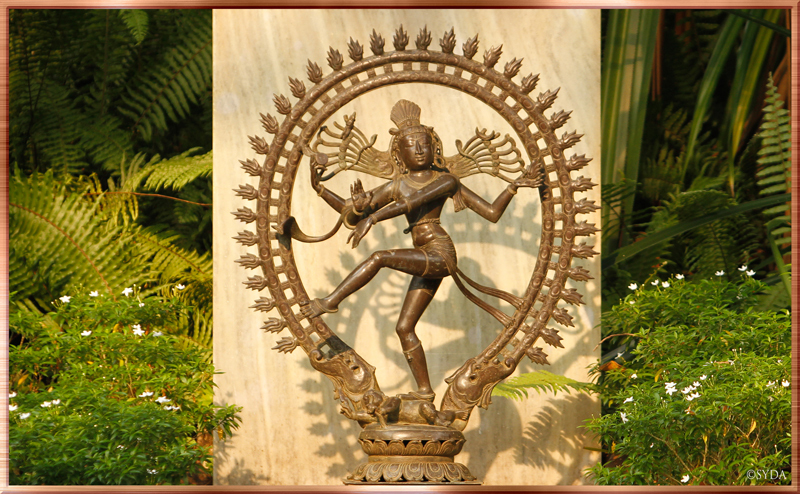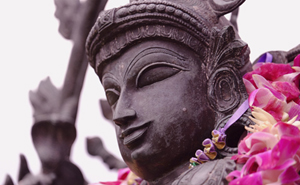Shiva, Lord of the Sacred Dance

An Exposition by Mark McLaughlin
Who is Lord Śiva? How can we know Lord Śiva?
Lord Śiva is a deeply beloved and revered form of God in India. Among deities, he is immediately recognizable with his long, matted hair and ash-covered pale-blue body clad in animal skins. His very name—Śiva—means “auspicious,” “propitious,” “gracious,” “favorable,” and “benevolent.” He is often called the Auspicious One.
On the Siddha Yoga path, Lord Śiva is revered as one’s own inner Self. Śiva is also the deity of the initiation mantra given by the Siddha Yoga Gurus, which is Oṁ Namaḥ Śivāya—”I honor Śiva, my own Self.” By repeating this mantra, we access the space of peace and stillness that is Lord Śiva because the mantra embodies that awareness. The mantra is the sound form of Śiva.
Lord Śiva is worshipped both as a deity and as the ultimate Principle. The scriptural traditions and philosophies that honor Lord Śiva often refer to him as Paramaśiva, Supreme Śiva. This is Śiva as the absolute Consciousness that is both immanent and transcendent—the one who becomes the universe at the same time that he exists beyond the universe. Lord Śiva is understood to be That which gives rise to all. He is the source of manifestation, its preserver, and That into which it eventually dissolves.
Devotees and yogis worship Lord Śiva as one or several of his many guises. He is Ādi-guru, the primordial Master, who guides seekers on their quest for liberation and the knowledge of God. In Śrī Guru Gītā, we witness the revelation of his teachings in dialogue with Devī, his disciple. As Ādi-guru, his infinite love flows down through the lineages of God-realized spiritual Masters who bestow the Lord’s power of grace.
Lord Śiva is the majestic Mahādeva, the Great God, who oversees the universe. He is the ascetic Mahāyogin, the Great Yogi, who is depicted absorbed in deep meditation. He is the fierce Rudra the Destroyer, who removes the ignorance that binds us to the limited understanding of Reality. He is also depicted as a dharmic householder, along with his wife, Pārvatī, and their two sons, Gaṇeśa and Kārttikeya. Then there is his image as Ardhanārīśvara, which simultaneously encompasses Śiva and Śakti, the masculine and the feminine, as God who is the immovable stillness of the formless Absolute and Goddess who is the dynamic power that actuates and sustains this manifest world.
Lord Śiva is the compassionate Āśutoṣa, “the one who is easily pleased.” He is as well Śambhu, the source of bliss, the bestower of happiness, and the abode of joy.
Most significantly, Lord Śiva is the great Ātman, the blissful Consciousness that is the essential being of all creation—the Self of all, the Heart of all. This is most profoundly exemplified by the śiva-liṅgam, the aniconic emblem of Lord Śiva found at the center of most Śiva temples. This cylindrical column, and the pedestal it is embedded within, encapsulate the principles of Śiva and Śakti, the formless Absolute inseparable from its all-pervasive Power.
There is one other form of Lord Śiva that is widely reverenced—a classical form that was developed and worshipped at Chidambaram in South India—and this is Naṭarāja, the Lord of the Dance. It is one of the best-known visual forms of Lord Śiva, and because it so clearly conveys his attributes, it is an excellent way to come to know him.
With sublime beauty, rhythm, and balance, the powerful image of Śiva Naṭarāja stands in front of the main entrance of both the Atma Nidhi and Anugraha lobbies of Shree Muktananda Ashram in New York, and in the gardens of Gurudev Siddha Peeth, the Siddha Yoga Ashram in Ganeshpuri, India. This image is perhaps the most articulate representation of divine activities ever communicated through art.
The multifaceted and enigmatic appearance of Śiva Naṭarāja is often referred to as Ānanda Tāṇḍava, his “Dance of Bliss,” by which the Lord simultaneously and continuously brings the world into and out of existence.
Of all the forms of Lord Śiva, that of Naṭarāja perhaps most fully exhibits the dynamic aspects of the Lord. Taking a close look at this breathtaking form will give us a profound understanding of his mysterious nature. And in so doing, we will also come to learn that, in a way, this image describes who we truly are.
Śiva Naṭarāja indicates the unending movements of the divine play of Consciousness. With limbs in motion, head swaying back and forth, and long, matted hair fanning out, Lord Śiva manifests his five acts: creation, preservation, dissolution, concealment, and grace.
In this image, the Lord dances on the form of a tiny demon, Apasmāra Puruṣa, the symbol of ignorance and forgetfulness. Unfettered by ignorance, Śiva is ever free and blissful. In his upper right hand, he holds the ḍamaru, the small drum from which he produces the pulsations of mātṛkā-śakti, the sound vibrations represented by the Sanskrit alphabet that take form as the entire universe. This is Śiva’s first act, the Dance of Creation.

The pulsations emanating from his drum are the very same vibrations that the ancient ṛṣis experienced in deep meditation and which they then expressed in the form of utterances. These verbal articulations, then, became the verses of the sacred Vedas and the revealed texts of the Śaiva Āgamas.
Śiva’s lower right hand is in the abhaya mudrā, the gesture that bestows fearlessness and the blessings that preserve the manifest world. This is Śiva’s second act, the Dance of Preservation.

His upper left hand holds the fire by which everything is eventually consumed at the end of its cycle. This is Śiva’s third act, the Dance of Dissolution.

His lower left arm crosses over the heart, veiling it. Though Śiva, as pure Consciousness, manifests the world, for us he remains hidden within it. This is Śiva’s fourth act, the Dance of Concealment.

Śiva’s lower left hand points at his uplifted left foot, which represents the flow of grace that sets us free from our limited understanding, for just as Śiva enacts his power of concealment, he also initiates his power to reveal himself as the essence of Reality. This is Śiva’s fifth and final act, which is embodied by the enlightened Guru who liberates us from the bondage of worldly existence and awakens us to our true nature as supreme Consciousness, the Self. The fifth act is Śiva’s Dance of Grace.

Through its gestures, the form of this majestic Śiva Naṭarāja eloquently represents the very source of existence—supreme Consciousness, the great Self of all. What is the secret that Naṭarāja conveys to us? What is Lord Śiva calling out to us? What is the message he wishes to impart to spiritual seekers?
Looking even more closely at Śiva Naṭarāja, we notice that Śiva’s face reveals an expression of uninterrupted serenity. Śiva’s eyes seem wholly indrawn, as if contemplating the tranquility of his innermost Self. The facial features are still, without any gesture or movement, and a gentle contented smile plays across his face. Śiva gazes inwardly into his transcendent inner state at the same time that he is gazing at his own dynamic energy spreading out as the universe. His expression reflects the stillness from which everything emanates, reminding us of the immovable column of golden light reified as the śiva-liṅgam and out of which Śakti brings forth all manifestation.

The Lord as Naṭarāja calls to us to recognize that this entire dance of the cosmos, which emanates from the Lord’s being, unfolds from a point of complete stillness. The silence and the peace of Śiva’s innermost being is represented by the serenity of his face. Around him, the whole universe churns into manifestation from this still point of Consciousness.
If this seems like a paradox—that this dance of creation opens from complete stillness—well, it is. Śiva is known as the embodiment of paradox. He is formless, yet he has form. He is both creator and destroyer. He conceals and at the same time reveals. In his cosmic dance, Śiva is the stillness of the supreme Void, and his Śakti is the dynamic movement that emerges from this stillness.
As we marvel at Śiva as the cosmic dancer, we might ask ourselves: how are we related to his cosmic dance? How is each of us identified with it?
Think for a moment over the course of your life, from when you were a small child to this present moment. Throughout the changes you have experienced, what has remained constant? At the deepest core of your being, there is something that has unwaveringly witnessed your entire transient and fluctuating worldly existence. That unchanging aspect of you is your awareness, pure awareness. This is your deepest core, beyond all the layers of your constructed identity. This awareness, the spiritual Masters tell us, is your true identity—the Self. From the point of stillness that is the Self, the dance unfolds and takes shape as your experience of the world.
In the South Indian Śaiva text Tirumantiram, the great eighth-century Tamil sage Tirumular sings:
I searched and discovered within myself the sacred dance,
The feet adorned with tinkling anklets,
The mouth singing songs, and limbs moving,
Oh, how my sufferings disappeared.1
Tirumular is telling us that the sacred dance is within us. We are the cosmic dance of Śiva—creating, preserving, and dissolving our universe. The sages that taught nondual Śaivism in Kashmir call this svatantra, “freedom”—from the Sanskrit prefix sva, meaning “self,” and the verbal root tan, meaning “to spread out,” “to extend,” or “to weave.” Our world is self-woven, svatantra, created by the unimpeded free will of Consciousness. The freedom that is this Dance of Śiva pulses into being from the stillness at the core of our own Heart. In this perfect freedom, there is the experience of Śivo’ham, “I am Śiva.”
As we hold our attention on the beatific face of Śiva, the gracious glance of God begins to settle our mind… pulling us past our thoughts, beyond our mental activity, and into the still point deep within the Heart. Here we find complete rest. Total freedom. Serene quietude.
It is this place of quietude, this place of stillness in our own Heart, that the great sages invite us to encounter and make our own.
Among the many divine attributes that reveal the identity of Lord Śiva, there is one that the sages hold in highest reverence, and that is Śiva as mantra. The syllables of the mantra Oṁ Namaḥ Śivāya are each an expression of Śiva’s own Śakti. Indeed, the sage Tirumular reveals for us that the very sound of Śiva’s cosmic dance is reflected in the five syllables of Namaḥ Śivāya. The drum of creation is the syllable śi. The abhaya mudrā of preservation is the syllable vā. The fire of dissolution is ya. The foot destroying our limitations is na. And the lifted foot of grace is the syllable ma. Oṁ Namaḥ Śivāya…
Śiva Naṭarāja is the mantra Oṁ Namaḥ Śivāya.
When repeating the mantra, give yourself to it, absorb yourself in its melodious vibrations—enter Ānanda Tāṇḍava, Lord Śiva’s Dance of Bliss.
May the form of Lord Śiva’s cosmic dance ever remind you that the gracious glance of God is always on you and the beatific face of Lord Śiva is always within you, shining out from the still point of your own Heart.



